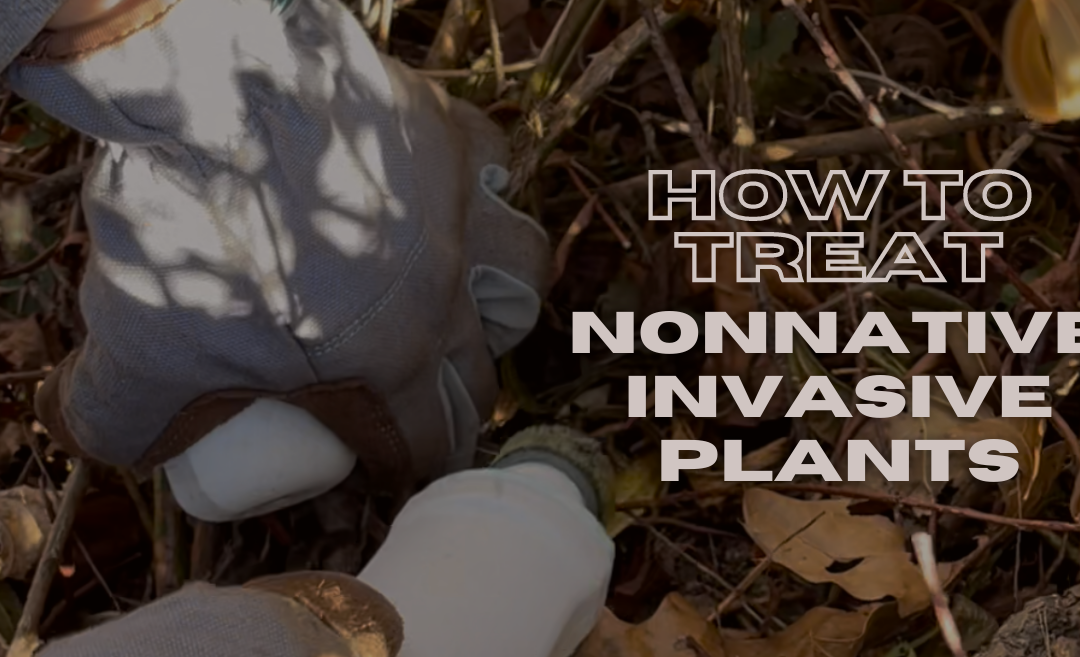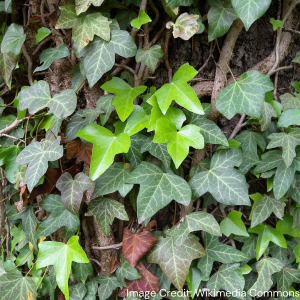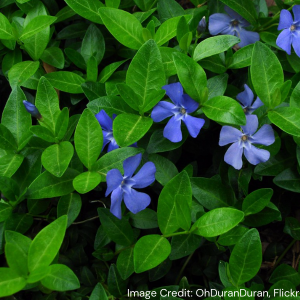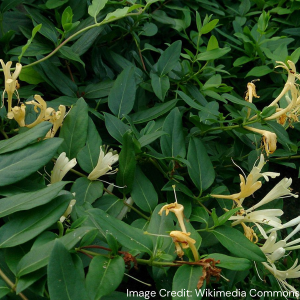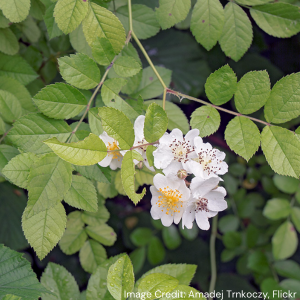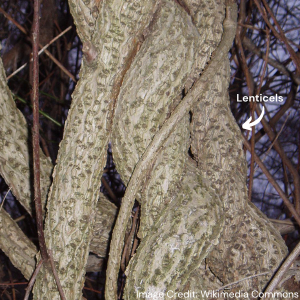‘Tis the Season to Treat Backyard Nonnative Invasive Plants
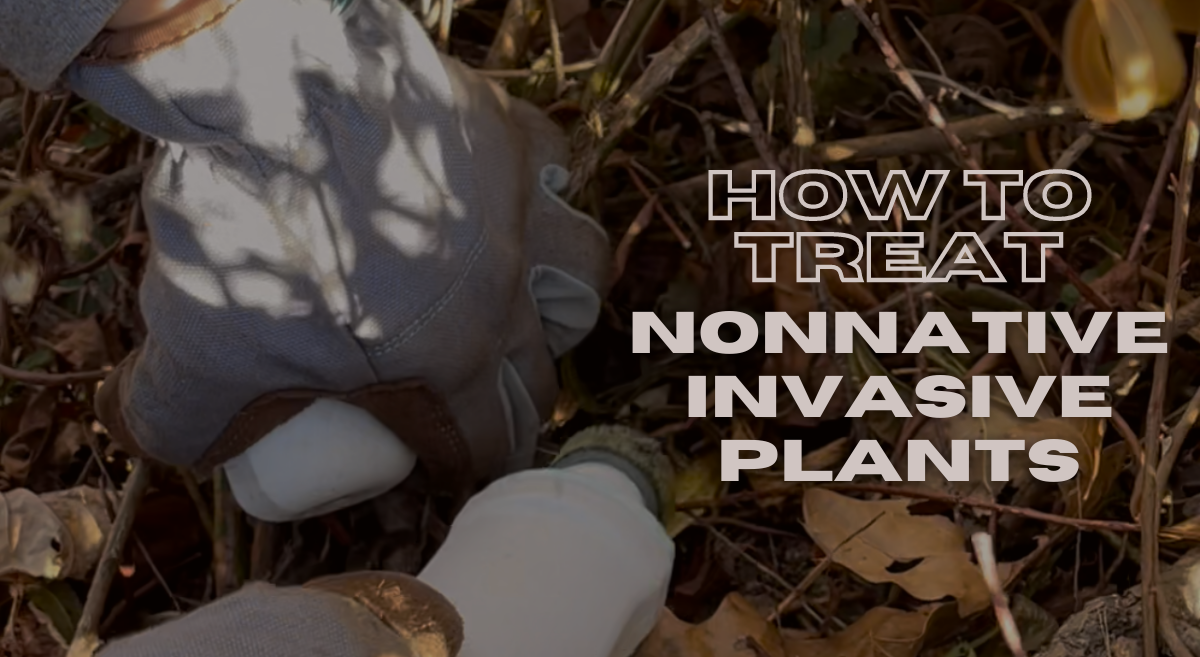
With winter around the corner, many of our region’s native plants now lay dormant — they’ve paused their seasonal growth to conserve their energy until springtime returns once again. The wintry absence of leaves, blooms, and other seasonal greenery makes it easier to spot common evergreen nonnative invasive plant species (NNIP) found throughout our region, in our backyards, and even in our gardens. Just because it’s cold outside doesn’t mean you have to say goodbye to your garden until spring — now is the perfect time to identify and weed out pesky NNIPs around your home! Read on and find out how you can identify and treat common backyard NNIPs.
Why are NNIPs bad?
Abundant, thriving native biodiversity is our best defense against climate change. The harmful presence of NNIPs decreases the capacity of ecosystems to withstand the effects of climate change. NNIPs are capable of fundamentally altering the natural state of any ecosystem they invade, compromising the ability of native plant and animal species to survive. NNIPs pose major threats to biodiversity as they compete with native plant and animal species for resources like sunlight, water, nutrients, and space.
According to the US Forest Service, “invasive species have contributed to the decline of 42% of US endangered and threatened species,” serving as the primary cause of decline for 18% of the country’s endangered or threatened species. Learning and sharing knowledge about NNIPs — like how to identify, remove, and treat them — is one of the best ways we can support native biodiversity and combat the effects of climate change locally. In fact, the Southern Appalachian Mountains are one of the most biodiverse regions in the temperate world — it’s up to all of us to work together to safeguard our region’s abundant biodiversity!
Identifying common NNIPs
Let’s review some of our region’s more noticeable NNIPs. If you discover your garden has been invaded by one or more of these common NNIPs, know that you’re not alone — you can use your newfound NNIP knowledge to help treat and remove those pesky plants! If your situation requires the use of herbicides, remember to always observe labels.
Remove those roots!
Oftentimes, home gardeners can successfully remove NNIPs through mechanical control (digging them out), though herbicide use is also a good option for more challenging situations. When working with herbicide, it’s important to remember that the label is the law, so make sure to thoroughly read it and only use the product as directed — following the label helps you protect yourself and your natural surroundings.
For English ivy, vinca, and Japanese honeysuckle:
We recommend using glyphosate* as a foliar spray application. This time of year is particularly good for foliar spray applications, as other native plants that now lay dormant are less likely to be harmed by this herbicide application technique.
*A note on glyphosate: when treating NNIPs, we only recommend using glyphosate when other herbicides would be ineffective in comparison. Much of glyphosate’s bad press can be attributed to its overuse in large agricultural operations — its use in this setting differs from its use as a NNIP removal aid, where it can be used sparingly. Click here for more information on glyphosate.
For other NNIPs like sacred bamboo, multiflora rose, privet, and Oriental bittersweet:
We recommend a cut stump treatment using a dauber bottle filled with triclopyr. In this treatment method, the smallest effective amount of herbicide is directly applied in order to minimize harm to the surrounding environment. Use these pro tips for a successful cut stump treatment:
- Cut the NNIP within one inch of the ground
- Apply triclopyr within one minute of cutting for the highest chance of success — outside temperatures should be at least 40 degrees during application.
Questions? Contact our resident native plant expert and Western Region Program Coordinator, Tony Ward.
English Ivy
English ivy (Hedera helix) is easily identified by its dark green and glossy leaves with distinct white veins. Younger leaves have three to five lobes, but the lobes can become indistinct as the leaf matures. This vine attaches its aerial roots to walls and trees in cascading, blanket-like structures. Recommended treatment: foliar spray.
Periwinkle
Periwinkle (Vinca minor) is a semi-evergreen trailing NNIP — its cascading foliage has a blanket-like ground cover. Its thick oval-shaped, small, dark, and glossy leaves grow opposite each other, producing small purple flowers in the spring and fall seasons. Recommended treatment method: foliar spray.
Japanese Honeysuckle
Capable of growing up to 80 feet long, Japanese honeysuckle (Lonicera japonica) stems can become very thick, often forming dense clumps. This climbing NNIP can smother small native trees and shrubs. Stems are distinguishably tan and have opposite, elliptical-shaped leaves that produce light yellow and white tubular flowers in the spring and summer seasons. Recommended treatment method: foliar spray.
Sacred Bamboo
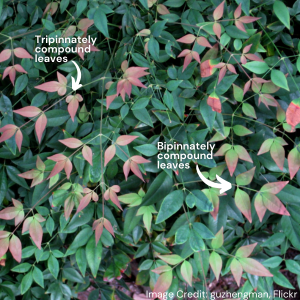 While Sacred bamboo’s (Nandina domestica) bright red berries persist throughout the winter, its leaves change color with the seasons and often turn a purplish-red in the colder months. Its opposite leathery-textured leaves have smooth edges and pointy tips. The leaves themselves are bi and tripinnately compound, so one leaf has several leaflets. Recommended treatment method: cut stump treatment.
While Sacred bamboo’s (Nandina domestica) bright red berries persist throughout the winter, its leaves change color with the seasons and often turn a purplish-red in the colder months. Its opposite leathery-textured leaves have smooth edges and pointy tips. The leaves themselves are bi and tripinnately compound, so one leaf has several leaflets. Recommended treatment method: cut stump treatment.
Privet
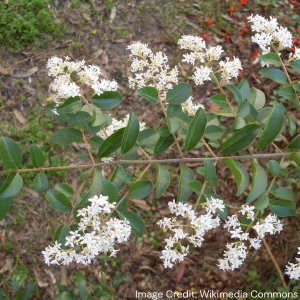 One of our region’s worst NNIPs, Privet (Ligustrum sinense) is a shrubby plant with “hair” — a.k.a., trichomes — growing densely along the twig when young. Its opposite oval-shaped leaves have smooth edges and are less than one inch wide. Its dark purple berries persist throughout the winter. Recommended treatment method: cut stump treatment.
One of our region’s worst NNIPs, Privet (Ligustrum sinense) is a shrubby plant with “hair” — a.k.a., trichomes — growing densely along the twig when young. Its opposite oval-shaped leaves have smooth edges and are less than one inch wide. Its dark purple berries persist throughout the winter. Recommended treatment method: cut stump treatment.
Multiflora Rose
Multiflora rose (Rosa multiflora) is a thorny shrub and climbing vine that can form thickets. Its opposite leaves stem directly above the thorn with five to eleven elliptical leaflets. This NNIP appears to have a set of eyelashes — known as fringed stipules — where its sharp-edged leaves connect to the stem. Its “eyelashes” distinguish multiflora rose from other rose species. Recommended treatment method: cut stump treatment.
Oriental Bittersweet
The last NNIP we’ll cover is Oriental bittersweet. Those who are familiar with this woody plant likely know it’s not an evergreen species. However, this NNIP is easily distinguishable thanks to the dark circles on its bark, which are formed by its lenticels — the woody stem’s raised pores that intake oxygen (O2) and release carbon dioxide (CO2) and water vapor (H2O). Its entwined vines are capable of astounding growth, frequently encircling and killing native trees via strangulation as they hoard sunlight. Recommended treatment method: cut stump treatment.
We hope this information inspires you to get out into your garden, backyard, or local green space to put your NNIP identification skills to the test. Check out this helpful resource for more information on NNIPs and NNIP removal, or reach out to our native plant and NNIP virtuosos (featured below).

